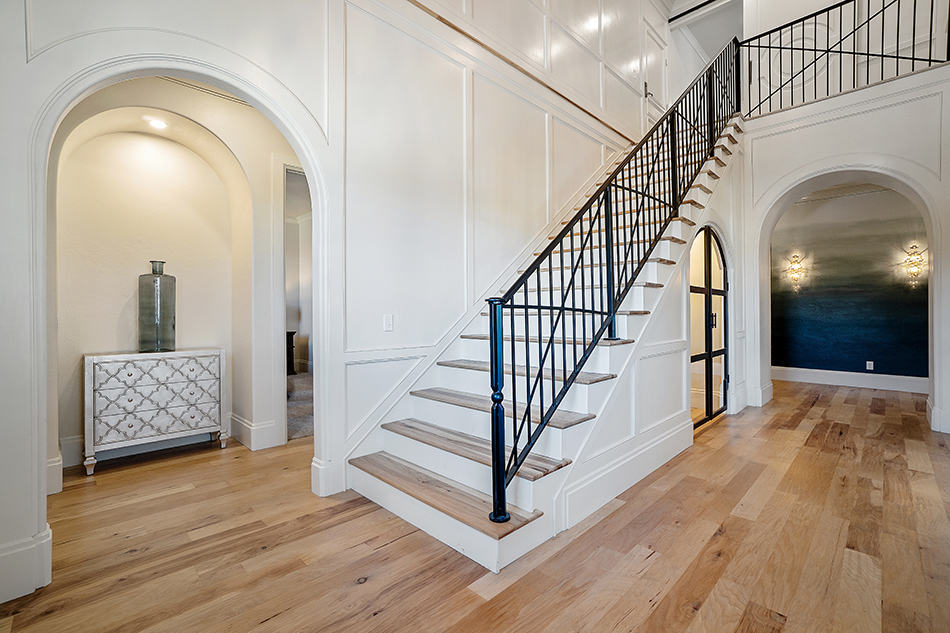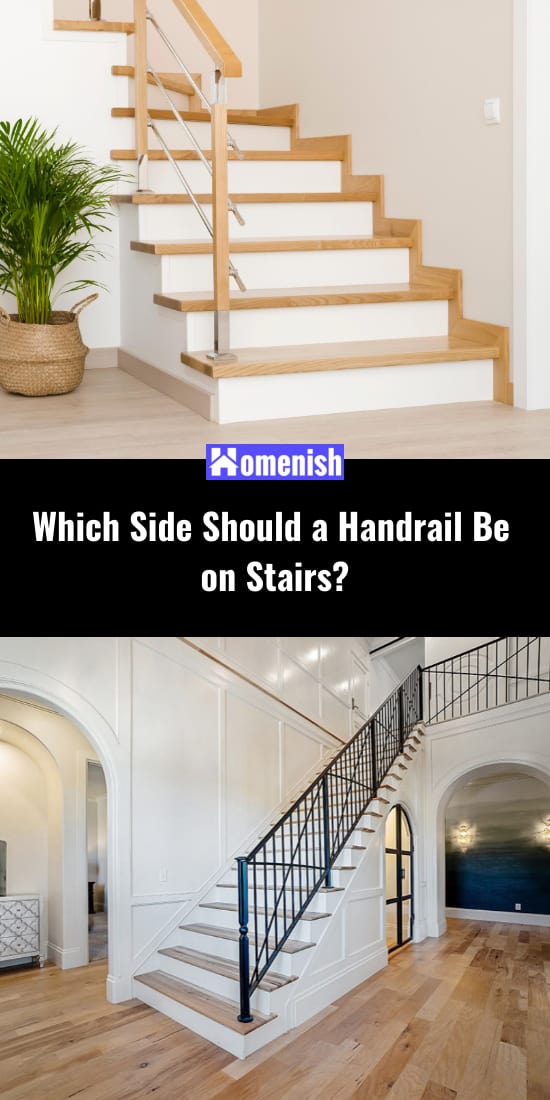Whether you’re building a new staircase or adding some safety features to your existing stairs, we’ll help you answer questions like, “Which side should handrail be on stairs?” “How many steps can you have without a handrail?” “How thick do your handrails need to be?” “How far out from the wall should you mount the handrails?”
The International Residential Code and the Americans with Disabilities Act will be our guide for the answers we share with you.
Which Side of the Stairs Should the Handrail Be Mounted On?
If you have an open side of the staircase, meaning one side doesn’t have a wall but is open to the floor below, you need to prevent this falling hazard by installing a railing on that side. If you have two open sides, railings need to be on both sides.
Any railing on an open side of the staircase also needs to have stair guards. These are vertical railings extending from the bottom of the stair to the handrail. Not only do these hold the handrail firmly in place, but it also prevents people from falling through the gap between the handrail and the stairs.
If you don’t have an open side on the stairs, you can choose to install the handrail on whichever side you wish. In general, people install the handrail on the right side when standing at the bottom of the stairs. This allows you to grip the handrail with your dominant hand as you climb the stairs.
If, however, you are installing stairs in a public building, you must install handrails on both sides to assist the disabled. It’s never wrong to install handrails on both sides of the stairs, and it can be a special help to elderly or unstable persons. This, of course, assumes you have wide enough stairs to install railings on both sides.
Do Handrails Need to Be Continuous?
In general, handrails should be continuous, meaning you shouldn’t have any gaps in the railing, but if you need to, you can switch which side the railing is on.
For instance, if you have an open side for a portion of the stairs on the right, then an open side on the left for the remainder, you can switch which side the railing is on. This saves you space on the stairs as you won’t have to install continuous railings on both sides.
You can also switch handrail sides if the stairs turn a corner. Finally, if you have a landing with no open stairs, you do not need a railing on the landing. However, the best practice is to have continuous handrails from the top to the bottom of the staircase to ensure maximum safety.
Minimum Railing Distance
You also need to make sure your staircase is wide enough to accommodate railings on one or both sides. You need to have 31.5 inches between the wall and the railing on a closed staircase. So, you need to leave 31.5 inches of walking space.
If you have railings on both sides of the stairs, leave at least 27 inches of walking space.
When you’re measuring, take into account that the handrail itself needs to be at least 1.5 inches from the wall and extend no more than 4.5 inches onto the stairs.
So, if you have a total stair width of fewer than 33 inches (1.5 inches from the handrail to the wall and 31.5 inches of walking space), you cannot install a handrail and still pass a building inspection. For installing railing on both sides, your stair width needs to be at least 30 inches (1.5 inches on both sides from the rail to the wall and 27 inches of walking space).
The reason the handrail needs to be at least 1.5 inches away from the wall is so that you can grip the railing without running your hand along the wall. The reason the railing can’t extend more than 4.5 inches over the stairs is so that children aren’t tempted to climb the outside of the staircase.
How High Should Your Railing Be?
You have some wriggle room here, but again, it depends on if the railing is on an open side of the staircase or not. If it is on an open side, the railing needs to be between 36 and 38 inches, and remember, your guards need to come up at least 36 inches.
On a closed side, your railing can be between 30 and 38 inches high. A best practice, of course, is to keep railings the same height on one side and match it on the other side if you’re installing handrails on both sides. Most railings are 36 or 37 inches high.
How Thick Should Your Handrails Be?
Again, because you need to be able to grab onto the handrail comfortably, it should be between 1.25 and 2 inches in diameter. Any stair guards or hardware that connects the railing to the wall should not interrupt your grip on the railing.
Instead, they need to connect to the bottom of the railing so that you never have to take your hand off the railing or loosen your hold to skip over the hardware.
How Much Weight Can You Put on a Handrail?
When installed properly, and handrail and any stair guards should be able to hold at least 200 pounds. While you don’t want to slide down the railing, this load capacity ensures the railing will hold if someone falls into it.
Ensure that your stair guards are strong enough and secured well enough to withstand this amount of weight. If you’re installing a handrail with brackets, make sure you install the brackets into the studs on the wall and not simply into the drywall.
How Many Steps Can You Have without a Handrail?
If you don’t want to install a handrail, you are permitted to have up to three steps on a staircase with no railing. This applies to both interior and exterior stairs. If you have four or more stairs, you do need to install a railing.
Again, it’s never wrong to install a railing, and doing so will only enhance the safety of your stairs. Falling down three stairs, however, is unlikely to cause major injury, so you aren’t required to install a railing for such short staircases.







